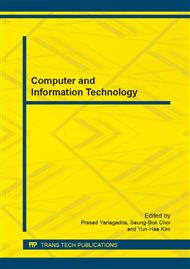p.680
p.684
p.689
p.693
p.697
p.703
p.708
p.714
p.719
Triangle Rasterizer Based on the Barycentric Arithmetic
Abstract:
A triangle rasterizer features the barycentric arithmetic for rasterization operation in graphics processors is introduced in this paper. First, the common method for triangle rasterization is presented, and its drawbacks of lacking simplicity and introducing accumutive errors are highlighted. Then, the new approach using the barycentric arithmetic is discussed in detail, including finding the pixels belong to the triangle and interpolating attributes for these pixels. At the basis of that, the hardware structure of the rasterizer is proposed with elaboration of the bounding rectangle establishment and the pipelined divider in it. At last, the RTL simulation result of the proposed rasterizer is given and analyzed, which has shown that the rasterizer can generate pixels efficiently and accurately.
Info:
Periodical:
Pages:
697-702
Citation:
Online since:
February 2014
Authors:
Price:
Сopyright:
© 2014 Trans Tech Publications Ltd. All Rights Reserved
Share:
Citation:


